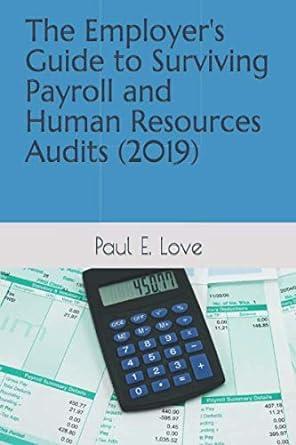Question
Q1: When a taxpayer's projected household income is more than the actual income and the premium tax credit (PTC) is added to the taxpayer's refund,
Q1:
When a taxpayer's projected household income is more than the actual income and the premium tax credit (PTC) is added to the taxpayer's refund, which scenario must occur in order for the taxpayer to itemize the health insurance premium deductions on their Schedule A?
The taxpayer must increase the deductible health insurance premiums by the amount of refundable PTC.
The taxpayer will not do anything. They can take the allowable deductions for the health premiums as they are.
The taxpayer must reduce the deductible health insurance premiums by the amount of refundable PTC.
The taxpayer cannot itemize any of the deductible health insurance premiums since the PTC was refunded.
Q2:
Which calculation method is most accurate for a taxpayer that qualifies for the self-employed health insurance deduction (SEHID) and the premium tax credit (PTC)?
The iterative calculation method.
The simplified calculation method.
Both A and B.
None of the above.
Q3: Which of the following circumstances is a scenario that will NOT trigger a shared policy allocation calculation?
The taxpayer is married at the beginning of the year, and files separately at the end of the year.
The taxpayer is married at the beginning of the year, and is legally separated at the end of the year.
A dependent listed on a Form 1095-A is claimed by another taxpayer.
An unmarried parent claims a dependent listed on Form 1095-A.
Q4:
Which of the following forms is an applicable large employer required to file with the IRS to show that it offered coverage to an employee?
Form 1095-A.
Form 1095-C.
Form 1099-MISC.
Both A and B.
Q5. Generally, in 2016, an applicable large employer (ALE) is required under the employer shared responsibility provisions to do which of the following?
Offer affordable minimum essential health insurance coverage to full-time employees, their spouses, and their dependents under an eligible employer-sponsored plan.
Offer affordable minimum essential health insurance coverage to full-time and part-time employees and their dependents under an eligible employer-sponsored plan.
Offer affordable minimum essential health insurance coverage to full-time employees and their dependents under an eligible employer-sponsored plan.
Offer affordable minimum essential health insurance coverage to full-time employees and their dependents, including step children and foster children, under an eligible employer-sponsored plan.
Step by Step Solution
There are 3 Steps involved in it
Step: 1

Get Instant Access to Expert-Tailored Solutions
See step-by-step solutions with expert insights and AI powered tools for academic success
Step: 2

Step: 3

Ace Your Homework with AI
Get the answers you need in no time with our AI-driven, step-by-step assistance
Get Started


